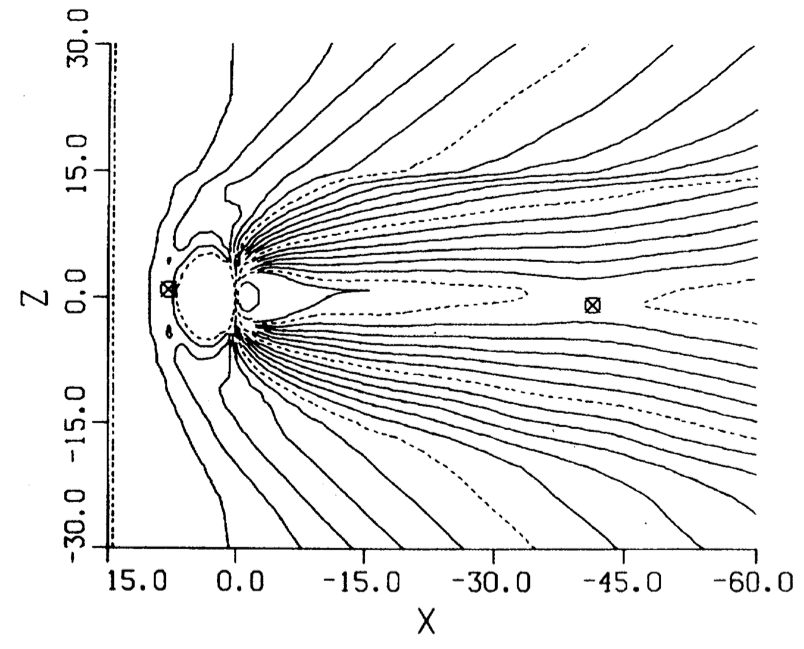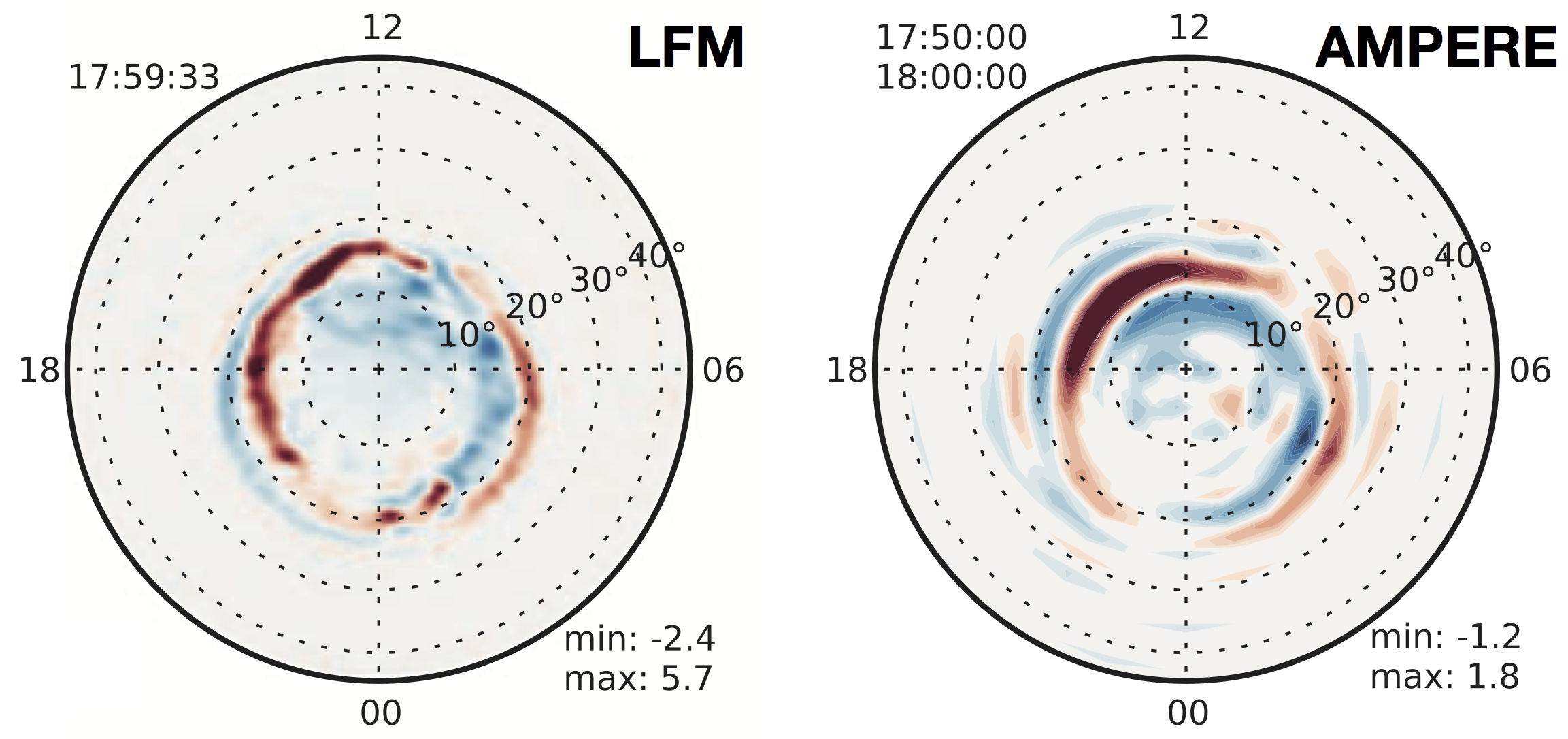GAMERA
Grid Agnostic MHD for Extended Research Applications

About
GAMERA is a new magnetohydrodynamic (MHD) simulation tool building and improving upon the high-heritage Lyon-Fedder-Mobarry (LFM) code. GAMERA has been written completely from scratch in modern Fortran and provides a flexible, portable, and exascale-capable MHD code. GAMERA features multiple improvements over LFM including: minimal external library dependence, high degree of optimization, OpenMP parallelism allowing use of heterogeneous architectures, and multiple numerics upgrades. Thus, while preserving all key numerical algorithms underlying the LFM code, GAMERA provides a robust and user-friendly solution for sustainable future.
In CGS, a global magnetosphere configuration of GAMERA will serve as the backbone of the geospace part of the MAGE model, will incorporate the other magnetospheric components and ultimately couple to the WACCM-X model of the atmosphere-ionosphere system.
Contact info: gamera-devel@listserv.jhuapl.edu
History
LFM code was rewritten by J. Lyon, J. Fedder and C. Mobarry at NRL in the 1980's. Its heritage is traced back to pioneering work on Flux Corrected Transport (FCT) schemes in the same group (J. Boris, D. Book, S. Zalesak, K. Hain). Initial simulations started with very high order spatial interpolation schemes (e.g., 20th order), which was later reduced to 8th order standard today. Over the years, the LFM code or its derivatives have been applied to the terrestrial magnetosphere, planetary magnetospheres (Saturn, Neptune, Uranus, Venus), to inner and outer heliosphere, and regional magnetotail simulations. In 2000's the code was MPI-parallelized which allowed very high resolution simulations reproducing magnetopause boundary instabilities (Kelvin-Helmholtz) and flux-tranfer events (FTEs), ionospheric field-aligned currents with remarkable resemblence to observations, and dipolarization fronts in the magnetotail. Also in 2000's, as part of the Center for Integrated Space Weather Modeling (CISM), a geospace model coupling framework was developed, which allowed implementation of coupling with the Rice Convection Model (RCM) of the inner magnetosphere and the NCAR TIEGCM model of the ionosphere-thermosphere. Finally, in the late 2000's LFM was extended to include the capability to simulate multiple ion fluids. This extension has become known as Multi-Fluid LFM (MFLFM).
Applications
GAMERA was written in a very flexible way and allows easy adaptation to different geometries and initial/boundary conditions via user files. The primary current applications are the terrestrial magnetosphere, the inner heliosphere/solar wind, magnetospheres of outer planets, current sheets and reconnection, and MHD instabilities (e.g, Kelvin-Helmholtz and Rayleigh-Taylor.)
Algorithms
- Curvilinear grids
- A key distinguishing feature of the LFM/GAMERA MHD algorithm is its finite-volume formulation allowing arbitrary (including non-orthogonal) hexahedral grids.
- This allows adapting the grid to the geometry of the problem (e.g., packing more grid cells around the magnetopause in magnetospheric calculations) and overall high resolving power with a relatively small total number of grid cells.
- GAMERA improves on the previous LFM algorithm by employing a higher order metrics calculations (12th order Gaussian quadrature.)
- Partial interface method
- High (7th or 8th) order spatial interpolation of conserved variables.
- Aggressive Partial Donor Cell (PDM) Limiter and Left/Right state splitting on primitive variables. Clipping and non-clipping options.
- Flux calculation uses the gas-kinetic method. However, implementation is flexible and other flux functions can be used.
- Constrained transport (magnetic flux are defined at cell faces, while electric field is defined at cell edges) keeps magnetic field divergenceless to round-off error.
- Pole axis treatment (Ring Average) for spherical and cylindrical geometries.
- Background magnetic field subtraction is necessary in magnetospheric simulations to remove the dominant planetary dipole from field calculations.
- Conservative and semi-conservative energy equation treatment (total and plasma energy formulations.)
- Boris correction is critical in magnetospheric simulations where Alfvén speed becomes prohibitevly large near the planet.
- For magnetospheric applications we have also completely rewritten the ionospheric solver from the LFM code (MIX) and integrated the new Fortran code with GAMERA. The new solver (dubbed reMIX) incorporates the standard LFM ionospheric conductivity model, including ionization by solar irradiance and magnetospheric electron precipitation.
References
Lyon, J. G., Fedder, J. A., & Mobarry, C. M. (2004). The Lyon-Fedder-Mobarry (LFM) global MHD magnetospheric simulation code. Journal of Atmospheric and Solar-Terrestrial Physics, 66, 1333. http://doi.org/10.1016/j.jastp.2004.03.020
Merkin, V. G., & Lyon, J. G. (2010). Effects of the low-latitude ionospheric boundary condition on the global magnetosphere. Journal of Geophysical Research, 115(A), A10202. http://doi.org/10.1029/2010JA015461
Sorathia, K. A., Merkin, V. G., Panov, E. V., Zhang, B., Lyon, J. G., & Garretson, J., et al. (2020). Ballooning‐interchange instability in the near‐Earth plasma sheet and auroral beads: Global magnetospheric modeling at the limit of the MHD approximation. Geophysical Research Letters, 47, e2020GL088227. https://doi.org/10.1029/2020GL088227
Zhang, B, K. Sorathia, J. Lyon, V. G. Merkin, & M. Wiltberger (2018), Conservative Averaging-reconstruction techniques (Ring Average) for 3-D finite-volume MHD solvers with axis singularity, J. Comput. Phys., https://doi.org/10.1016/j.jcp.2018.08.020
Zhang, B., Sorathia, K. A., Lyon, J. G., Merkin, V. G., Garretson, J. S., & Wiltberger, M. (2019). GAMERA: A Three-dimensional Finite-volume MHD Solver for Non-orthogonal Curvilinear Geometries. The Astrophysical Journal Supplement Series, 244(1), 20, https://doi.org/10.3847%2F1538-4365%2Fab3a4c.

